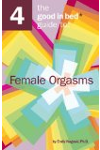There is no particular facial expression that indicates orgasm; instead what’s important is that at orgasm your partner is not thinking about his or her face. The “O” face -- jaw dropped in an elongated O shape -- is only one possibility among many. Your partner may have his or her lips barely parted, jaw tense. There may be a crinkle between the eyebrows, or eyebrows may be raised up into the hairline. Lots of people close their eyes at orgasm, the better to focus on the sensations inside their bodies, but it’s not at all necessary. (Orgasming while looking into your partner’s eyes is an intimate and lovely thing. Do try it if you haven’t.) The thing to notice is that it’s utterly unself-conscious, that their attention is turned away from their appearance, the social mask is gone, and you have an unmediated view of the person under the persona.

More About this Book
The Good in Bed Guide to Female Orgasms
Continue Learning about Orgasm
Important: This content reflects information from various individuals and organizations and may offer alternative or opposing points of view. It should not be used for medical advice, diagnosis or treatment. As always, you should consult with your healthcare provider about your specific health needs.
